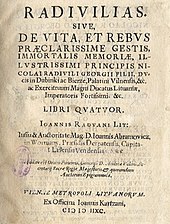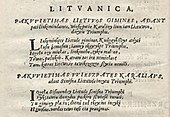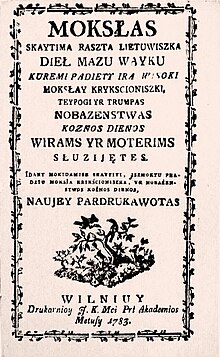Lithuanian literature
His poem Carmen de statura, feritate ac venatione bisontis (A Song about the Appearance, Savagery and Hunting of the Bison), published in 1523, describes the Lithuanian landscape, way of life and customs, touches on existing political problems and reflects the clash of paganism and Christianity.
Joannes Vislicensis (1485–1520) wrote Bellum Prutenum (Prussian war), an epic poem which was dedicated to the Battle of Grunwald against the Teutonic order.
A person under the pseudonym Michalo Lituanus [lt] (about 1490 – 1560) wrote a treatise De moribus tartarorum, lituanorum et moscorum (On the Customs of Tatars, Lithuanians and Muscovites) in the middle of the 16th century, but it was not published until 1615.
Augustinus Rotundus (about 1520 – 1582) was a publicist, lawyer, and mayor of Vilnius, who wrote a history of Lithuania in Latin around the year 1560 (no known manuscript has survived).
His most notable works are Chronicon des Landes Preussen (1578–1579), Postilla, tatai esti trumpas ir prastas išguldimas evangeliu (1591), Kancionalas nekurių giesmių (1589), a manuscript of Lithuanian Bible - Biblia (1590).
Chilinskis also issued two brochures in which he explained his work to the British society and the necessity to publish the Bible in Lithuanian with short information about the Grand Duchy of Lithuania - An Account of the Translation of the Bible into the Lithuanian Tongue (1659) and Ratio institutae translationis Bibliorum in linguam Lithuanicam, in quam nunquam adhuc Scriptura sacra est versa, ex quo fidem Christianam, ab conjunctionem Magni Ducatus Lithvaniae cum Regno Poloniae (1659).
Antanas Baranauskas (1835–1902) wrote the poem Anykščių šilelis (The Forest/Pinewood of Anykščiai, a programmatic work whose main aim was to uncover the beauty of the Lithuanian language and to demonstrate its suitability for poetry.
The theoretical basis of Keturi vėjai initially was futurism which arrived through Russia from the West; later influences were cubism, dadaism, surrealism, unanimism, and German expressionism.
His many works include Dainavos šalies senų žmonių padavimai (Old Folks' Tales of Dainava, 1912) and the historical dramas Šarūnas (1911), Skirgaila (1925), and Mindaugo mirtis (The Death of Mindaugas, 1935).
His most notable works are the novel Kuprelis (The Humpback, 1913) and Raudonasis tvanas (The Red Flood, 1940), firstly written in Swedish as Den röda floden.
His works often feature sharp and playful wit and irony, elegant and light writing, succinct and finely tuned sentences.
His most notable works are the short story collection Raudoni batukai (The Red Shoes, 1951) and his war-time diary Žemė dega (Earth on Fire, 1956).
Main works - Mūsų uždavinys (Our Task, 1911), Tautos gyvata (The Life of the Nation, 1920), Sieben Hundert Jahre deutsch-litauischer Beziehungen (Seven Hundred Years of German-Lithuanian Relations, 1932).
Oskaras Milašius (Oscar Vladislas de Lubicz Milosz) (1877–1939) was born and spent his childhood in Čerėja (near Mogilev, Belarus).
Ieva Simonaitytė (1897–1978) represented the culture of Lithuania Minor and Klaipėda Region, territories of German East Prussia with a large, but dwindling, Lithuanian population.
His poems connect ancient Lithuanian polytheistic religion and mythology with Greek and Sumerian myths, intertwining the old and new worlds with the ode to life and vitality.
While he was a professor at Vilnius University, he became involved in the Lithuanian Helsinki Group,[14] a human rights organization that included protests against Soviet activities in Lithuania.
Ričardas Gavelis (1950–2002) was a writer, playwright, journalist and the author of Vilniaus pokeris (translated as Vilnius Poker) and several other novels and collections of short stories.
In his most famous novel Žalčio žvilgsnis (The Serpent's Gaze, 1981) he explores the problem of evil and destruction which unnoticeably penetrates the family and generations.
Jurgis Kunčinas (1947–2002), Ričardas Gavelis (1950–2002), and Jurga Ivanauskaitė (1961–2007) wrote novels exploring the Lithuanian condition during the late 20th century.
Her first novel, Between Shades of Gray (2011), about the Genocide of Lithuanian people after the Soviet occupation in 1941, was critically acclaimed and translated into over 30 different languages.
The book Partizanai (The Partisans) by Juozas Lukša-Daumantas has been issued multiple times in Lithuania and published in the US as Fighters for Freedom.
The most famous representatives of the Lithuanian deportee literature are Dalia Grinkevičiūtė[20] (1927–1987), Valentas Ardžiūnas (1933–2007), Leonardas Matuzevičius (1923 – 2000), Petras Zablockas (1914–2008), Kazys Inčiūra (1906–1974), Antanas Miškinis (1905–1983).
[23] These authors include Antanas Škėma (1910–1961), Alfonsas Nyka-Nyliūnas (1919–2015), Marius Katiliškis (1914–1980), Kazys Bradūnas (1917–2009), Bernardas Brazdžionis (1907–2002), Henrikas Radauskas (1910–1970) and many others.
Five poets usually classified as Žemininkai are Juozas Kėkštas (1915–1981), Kazys Bradūnas, Alfonsas Nyka-Niliūnas, Henrikas Nagys (1920–1996) and Vytautas Mačernis (1921–1944) (posthumously).
[23] The most famous novel by Antanas Škėma, Baltoji drobulė (White Shroud, 1958) only recently was translated into English and German and got international acclaim.
Algis Budrys (1931–2008) was born into the family of a Lithuanian diplomat which didn't return to Lithuania after its occupation by the Soviet Union.
Through journalism, he became involved with Lithuania's restitution of independence during the fall of the Soviet Union in 1988–1991, and for this activity, he received the Knight's Cross medal from the Lithuanian government in 2004.
First fragments of literary criticism are found in writings and bookmarks of Danielius Kleinas (1609–1666), Michael Mörlin (1641–1708), Pilypas Ruigys (1675–1749) and others.
Simonas Vaišnoras (Varniškis) (1545–1600) was the first who wrote more comprehensively about Lithuanian literature in the preface of his Žemčiūga teologiška (The Pearl of Theology, 1600)[32]












